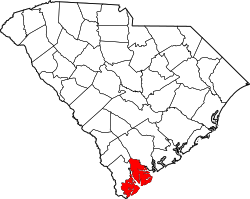Bluffton, South Carolina | |
|---|---|
 Clockwise from top: May River, Heyward House, a gravel path, Carecore Drive, a post office, Myrtle Island, and The Store | |
| Nickname: Heart of the Lowcountry | |
| Motto: "A State of Mind" | |
 Location of Bluffton in Beaufort County, South Carolina | |
| Coordinates: 32°13′50″N80°55′50″W / 32.23056°N 80.93056°W [1] | |
| Country | United States |
| State | South Carolina |
| Counties | Beaufort |
| Settled | 1728 |
| Incorporated | 1852 [2] |
| Named after | Original jurisdiction on a bluff above the May River [3] |
| Government | |
| • Type | Council–manager |
| • Body | Bluffton Town Council |
| Area | |
| 54.19 sq mi (140.36 km2) | |
| • Land | 51.97 sq mi (134.60 km2) |
| • Water | 2.23 sq mi (5.77 km2) 4.12% |
| Elevation | 20 ft (6.1 m) |
| Population | |
| 27,716 | |
| • Density | 533.3/sq mi (205.92/km2) |
| • Urban | 71,824 (US: 395th) [6] |
| • Urban density | 1,136/sq mi (438.5/km2) |
| Time zone | UTC−5 (EST) |
| • Summer (DST) | UTC−4 (EDT) |
| ZIP codes | 29909-29910 |
| Area code | 843, 854 |
| FIPS code | 45-07210 |
| GNIS feature ID | 2405288 [1] |
| Website | www |
Bluffton is a town in southern Beaufort County, South Carolina, United States. The population as of the 2020 census was 27,716, an increase of over 120% since the 2010 census, making it the 17th-most populous municipality and one of the fastest growing municipalities in South Carolina. [7] [8] It is primarily located around U.S. Route 278 between Hilton Head Island and Interstate 95. Bluffton is a principal town within the Hilton Head Island metropolitan area.
Contents
- History
- Colonial era (1670–1776)
- American Revolution (1776–1785)
- Antebellum era (1785–1861)
- Civil War and postbellum era (1861–1945)
- Contemporary era (1945–present)
- Geography
- Topography
- Climate
- Demographics
- 2020 census
- 2010 census
- Economy
- Arts and culture
- Society of Bluffton Artists
- May River Theatre
- Annual events
- Museums, historical sites and other attractions
- Parks and recreation
- Boat landings
- Government
- Education
- Infrastructure
- Transportation
- Emergency services
- Utilities
- Notable people
- See also
- References
- Works cited
- External links
The Lowcountry town's original one square mile area, now known as Old Town, is situated on a bluff along the May River. After the Tariff of 1842, Bluffton became a hotbed of separatist sentiment, which in turn led to a protest against federal taxes called the Bluffton Movement in 1844. Even though the movement quickly died out, it somewhat contributed to the secession movement that led to South Carolina being the first state to leave the Union. In the Antebellum Period, Bluffton became a popular location for wealthy merchants and plantation owners. During the Civil War, two thirds of the town was destroyed by fire during the Union's Bluffton Expedition on June 4, 1863. [9]












